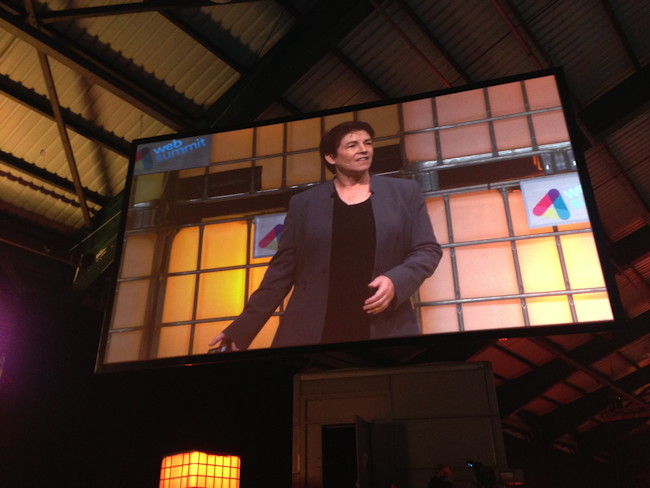Andra Keay, managing director, Silicon Valley Robotics
Robotic technologies are moving further into our lives, and Andra Keay is looking to bridge the gap between robotics research and the real world.
What is a robot? A cute, vaguely human-looking machine that trundles around helping you? A mechanical arm that carries out repetitive tasks on an assembly line? Or maybe the washing-machine sized Philae lander that last week bounced along the surface of comet 67P?
Depending on your perspective, some or all of the above are robots, but Keay prefers the term ‘robotic technologies’, and she sees them moving into our lives in a slow but sure revolution of connected devices and services.
As managing director at the non-profit industry group Silicon Valley Robotics in California, Keay seeks to represent robotics companies, start-ups and researchers, and to support the innovation and commercialisation of robotics technology.
“We aim to fit into the gap in between the research lab and the real world,” she explains.
Robotics past and present
Robotic technologies are already plentiful in the real world – in our vehicles, in ‘smart’ appliances in the home (Roomba, anyone?) and even beyond the world, with spacecraft, landers and rovers exploring other celestial objects.
Keay sees plenty more on the horizon, but she is wary of being too prescriptive about the technologies. While looking back at the 1960s sitcom Bewitched, it struck her that many aspects of the ‘magic’ house are today a reality.
“They were imagining chores being done by magic, but in many cases today we have, not a robot per se, but a whole heap of appliances or services to do those things – being able to order food on my mobile phone and have it dropped off at my door would have been like magic then, but now it’s commonplace,” she says.
“So today the challenge is to ask what do you want now, to free yourself from thinking about the limitations of the technology and let your imagination take you to what things do you want to have done, what problems do you want to solve. I think that is an exercise we should do all the time – when we are building things stop looking at the nuts and bolts and open our minds and start looking at what are the issues and problems, and redirect.”

Andra Keay, managing director, Silicon Valley Robotics, addressed the recent Web Summit in Dublin
Connectivity in the home
At the Web Summit in Dublin earlier this month, Keay was involved in panel discussions about the ‘connected home’, which brings the internet of things into our living space.
“I learned a lot from those panels,” she says. “Each person had a different understanding of the things they were trying to change, such as the delivery of power without wires, the delivery of light without wires, and cumulatively those became really exciting.”
However, Keay believes connected devices will move slowly into our homes, rather than in a rapid wave.
“Your house is an intensely personal and individual thing, and we need to keep that in mind when designing products – a product like a lock for the front door has to meet certain criteria of safety, reliability and accessibility and a certain level of aesthetic appeal, your home is your castle,” she says.
“So I think we will see increments of slightly more connected appliances rather than a lightbulb ‘a-ha’ moment of having a robot in the house, but, taken over a period of time these gradual changes will be significant.”
Food for thought at Food Summit
Keay, who was born in New Zealand, was particularly struck by the ingenuity of the Food Summit during her visit to Dublin.
“I enjoyed seeing the intersection of agriculture and technology and food technology, and I think this is somewhere we will see a big revolution in the coming years,” she says.
“Dairy robotics is already in use (where cows themselves interact with milking machines) and those systems are sophisticated, reliable, and one of the fastest growing commercial robotics sectors. They have answered a lot of the questions and now we need to provide the appropriate technology for similar benefits for other farm activities, such as better planting, weeding, fertilising, harvesting, movement of produce. Robotic technologies are allowing a shift, removing some of the worst parts of the drudgery of farming, and this may entice a new generation to work on the land.”
But no matter how good the technology is, the experts in using it are the farmers themselves, she notes.
“It’s about providing better information and services via this technology into the hands of the farmers and they take whatever actions they choose, they know the land.”
Research meets entrepreneurship
Keay is a founder of Robot Garden, a volunteer-led and family-friendly community hackerspace for robotics. And through Silicon Valley Robotics, she is keen to move robotic technologies from research towards our everyday lives, which she believes could be helped by more entrepreneurial training at universities.
“I think to want to go out and try to create a company is quite different to wanting to create a technology that is an improvement on existing technologies,” she says.
“So I think we could do more with integration of entrepreneurial culture into the labs, and I am involved with accelerators where I try to bridge that gap between people who like to build companies and people who like to build technologies and try to build better partnerships.”
Women Invent Tomorrow is Silicon Republic’s campaign to champion the role of women in science, technology, engineering and maths. It has been running since March 2013, and is kindly supported by Accenture Ireland, Intel, the Irish Research Council, ESB, Twitter, CoderDojo and Science Foundation Ireland.